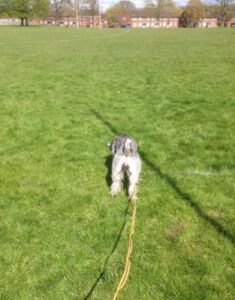Barks Blog
Scent Tracking as Part of Your ABC

When consulting on canine behavior problems, you will be looking at your ABCs – Antecedent – Behaviour – Consequence – as part of your functional assessment.
The immediate antecedents, such as direct environment, setting the dog off doing something the owner is not happy with, are often fairly easy to spot, although sometimes challenging to address. There are excellent protocols developed for that, such as BAT (Behaviour Adjustment Training, developed by Grisha Stewart), LAT (Look at That Training, developed by Leslie McDevitt, author of the book Control Unleashed) and Reactive aggressive dog training (developed by Emma Parsons, author of the book Click to Calm) for example, as well as variations and combinations of the above.
However, the distant antecedents can sometimes be a little more challenging to figure out and they may have at least as much influence on the unwanted behaviour in question as any immediate antecedent has.
What can a distant antecedent be? It can be breed traits, it can be early experiences in the dogs life and it can be accidental practice of the unwanted behaviour in slightly other forms than what the owner has called you for. I will develop that further in another blog.
Scent tracking comes in as trying to address distant antecedents such as lack of stimulation, lack of perceived bonding between the owner and dog, lack of calm, concentrated work. It taps in to something which is natural for the dog to do and I have yet not met a dog who doesn’t enjoy doing it. Any dog can do it and the results are often remarkable. The owner, once taught how to do it, enjoys it and often becomes very proud over their dog who is so talented.
Scent tracking is a natural way of stimulating a dog and it leads to generally calmer, more concentrated behaviour as well as, from the feedback I have had, it increases the bond between the owner and the dog.
A short introduction into how to teach scent tracking.
![]()
Material needed:
– Harness (non force)
– Leash/ long leash
– Small container with lid, which you put treats in.
– Two people (unless you are in an area where you can tie your dog up safely)
- Non busy grass or forest area (not hard surface to start with).
- Wind coming from behind you, i.e walk in the direction of the wind
- Put harness and leash on the dog, if he/she is not already wearing it
- Put treats in the little container, put lid on
- Leave dog with helper
- Walk in the direction of the wind
- Count 30 steps
- Stop, put little container exactly in front of your feet
- Step over container – CONTINUE 10 more steps straight forward
- Make a large u-turn, keep a distance from the original track (approximately 30 meters /35 yards)
- Go back to dog, take him/her a few steps into track and just wait.
- When the dog is taking up the track, praise with a very subtle voice and follow the dog
- If the dog goes wrong, just wait until he/she has found the track again, same as 10.
- When the dog has found the container, open it, feed the treats, praise, play and have fun!
- Leave by keeping away from any track to avoid back tracking or tracking without a reward, just play and have fun with the dog
- Teach all these steps to the owner so it can be done without you (the trainer/ behaviour consultant) being present
Best of luck! If you have further questions regarding this or how to plan your scent tracking training sessions, you can contact me via the comments section.
